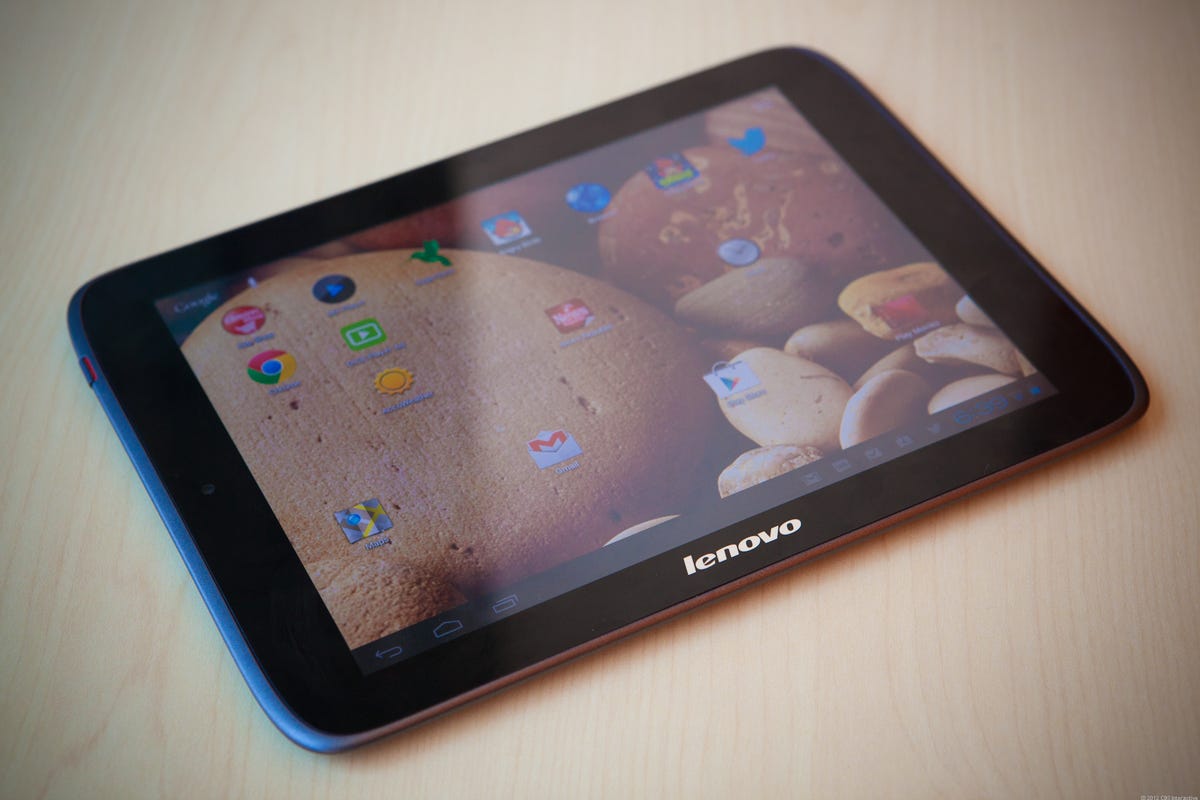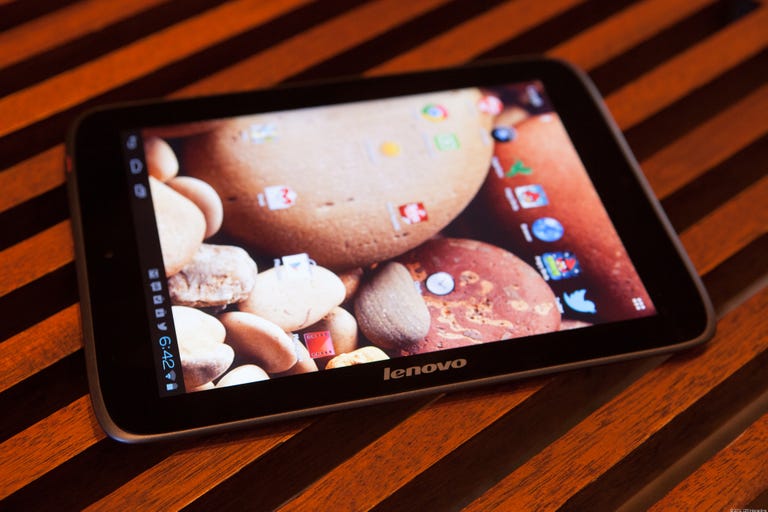 Why You Can Trust CNET
Why You Can Trust CNET Lenovo IdeaTab S2109 review: Lenovo IdeaTab S2109
The Lenovo IdeaTab S2109A would have made a great tablet a year ago, but the market moves fast and companies need to do better than this to keep up.
As technology advances, so do expectations and what was good, even three months ago, can be an overpriced waste of money today.
The Good
The Bad
The Bottom Line
Despite the Lenovo IdeaTab S2109A's performance issues (detailed below), price is the major deterrent. It's not terribly expensive and even includes some useful connections for its price. At the end of the day, however, you want to buy the best product, and unfortunately, the S2109A just can't hold a candle to other, similarly priced tablets that more clearly push the envelope in performance and features.
Design
Though it shares a few dimensional similarities with the iPad (and more specifically, the iPad 2), I doubt you'd have difficulty distinguishing the Lenovo IdeaTab S2109A from Apple's tablet. First, the similarities: each tablet houses a screen with a 4:3 aspect ratio, sporting a 1,024x768-pixel resolution. Dimensions and weight are also nearly identical, but the S2109A has a wider side bezel.
| Lenovo IdeaTab S2109A | Asus Transformer Pad TF300 | Samsung Galaxy Tab 2 10.1 | Apple iPad (2012) | |
|---|---|---|---|---|
| Weight in pounds | 1.3 | 1.4 | 1.24 | 1.34 |
| Width in inches (landscape) | 9.7 | 10.4 | 10.1 | 9.5 |
| Height in inches | 7.3 | 7.1 | 6.9 | 7.3 |
| Depth in inches | 0.35 | 0.38 | 0.34 | 0.34 |
| Side bezel width in inches (landscape) | 1 | 0.8 | 0.8 | 0.8 |

Then, the differences begin to slowly seep in. The S2109A's corners are more rounded and the beveled edges on the back aren't as dramatic. These more bulbous corners keep the tablet from digging into my palms, making it more comfortable to hold with two hands. The back is made of a medium-gray plastic panel that curves around the tablet's edge to the front, creeping a bit into the bezel. Unfortunately, this creates a seam between the bezel and the back panel that feels like shoddy workmanship and serves as an unintentional reservoir for small particles like crumbs, if you're the type (unlike me, of course) who likes to eat while you do tablety things. Not that there's anything wrong with that.
In the center of the left-side bezel is a 1.3-megapixel camera, and on the tablet's left edge is the easily depressible power/sleep button, with the headphone jack directly above it. On the left top edge sits the volume rocker.
Ports and connections, however, are what some buyers look to when making their tablet-purchasing decisions, and the S2109A shows up as fairly strong in that department. Along the right edge, from left are a microSD slot, a Micro-HDMI port, and a Micro-USB port. On the back are four speakers, two each on the right and left sides.
Overall build quality seems sturdy enough, but there's little chance you'd mistake this for a high-end device. It just lacks the kind of panache and sound design sensibilities you find on tablets like the Nexus 7 and Transformer TF300. It's difficult to articulate exactly what's "off," but if someone told you the S2109A costs less than $300 (it actually starts at $350 for 16GB), you'd probably reply with a "Yep. That sounds about right," rather than, "OMG! Amazeballs!!"
Software features
The S2109A ships with Android 4.0.4, but I didn't notice any changes from 4.0.3, and most of the apps included on the tablet can be pulled from the Google Play store for free. File Browser, which is a handy app that allows you to directly access files on the drive, is the only notable exclusive app addition.
The tablet also includes an SRS sound setting, allowing you to switch the speakers from music and movie mode, but this pales in comparison to SRS settings (like an Ambient Noise Equalizer) Toshiba offers on its tablets.
Hardware features
The S2109A houses a 1GHz dual-core OMAP 4430 processor and 1GB of DDR2 RAM, and comes in 16GB and 32GB varieties. Tablet mainstays like 802.11 b/g/n Wi-Fi support, Bluetooth 3.0, and GPS are included as well as gyroscope, accelerometer, and digital-compass support.
Performance
The S2109A uses an IPS panel for its screen, sporting wide viewing angles and a high brightness. And as mentioned, the screen runs at a resolution of 1,024x768 pixels. While that matches the screen specs of the iPad 2, it's actually lower than what you get on the vast majority of Android tablets. The lack of pixel density of the S2109A's screen isn't really noticeable in most apps; however, home screen text and text on the Web are noticeably blunted.
| Tested spec | Lenovo IdeaTab S2109A | Samsung Galaxy Tab 2 10.1 | Asus Transformer Pad TF300 | Apple iPad (2012) |
|---|---|---|---|---|
| Maximum brightness (Super IPS) | 411 cd/m2 | 380 cd/m2 | 331 cd/m2 | 455 cd/m2 |
| Default brightness | 185 cd/m2 | 213 cd/m2 | 135 cd/m2 | 160 cd/m2 |
| Maximum black level (Super IPS) | 0.32 cd/m2 | 0.39 cd/m2 | 0.22 cd/m2 | 0.49 cd/m2 |
| Default black level | 0.14 cd/m2 | 0.22 cd/m2 | 0.09 cd/m2 | 0.17 cd/m2 |
| Default contrast ratio | 1,284 | 974:1 | 1,504:1 | 941:1 |
| Maximum contrast ratio (Super IPS) | 1,321 | 968:1 | 1,500:1 | 928:1 |
When swiping through pages and navigating menus, the screen matches the sensitivity of most Android tablets out there but can't quite compete with the ubersensitivity of the Transformer Pad TF300, and on some occasions it was frustratingly difficult to swipe open the lock screen on the S2109A. Apps launched without delay, in that they began their launching process as I tapped the appropriate icon, but some larger apps, like games, clearly took longer to load compared with even other dual-core based tablets, like the Samsung Galaxy Tab 2 10.1.
Web and app download speeds were, on average, slower than when using most other Android tablets when within 5 feet of our test router. App downloads especially took up to four times longer to download than on the Galaxy Tab 2 10.1.
Thanks to its hardware scalability, I once again used Riptide GP as a game performance benchmark. Depending on the speed of the tablet's CPU, Riptide GP will deliver a noticeable increase or decrease in frame rate. The S2109A delivered playable frame rates, about on par with other 1GHz, dual-core-based tablets, but obviously didn't approach Tegra 3 levels of quad-core-infused performance.
Successfully playing movie files was fraught with frustrating inconsistency. MP4 and MOV files usually played without requiring much coaxing, but even that wasn't guaranteed. MKV files, though (once I could actually convince them to play; usually by restarting the tablet) played with stuttery performance. This was using the Dice Player, one of the most compatible players I know of, and again, isn't something I've seen lately with the deluge of Tegra 3 tablets I've crossed paths with.
If you do convince movies to play, the inclusion of four separate speakers does pay off, however, and the tablet's sound is loud, powerful, and fairly clear.
As mentioned, the S2109A has a front-facing 1.3-megapixel camera, and the 720p video recorded with it looks like 720p video recorded on a typical tablet: Webcam-looking stuff, with a distinct lack of clarity and washed-out colors. That is, if I could get the camera app to actually start.
The tablet never once crashed on me. While that statement may indicate I'm setting the bar too low, I mention it only because I did experience several app crashes or just nonstarting apps (like the camera app). This seemed to occur right after doing some high-bandwidth tasks on the tablet, like playing a couple of games and watching a movie. A restart "fixes" this, but that's not exactly my idea of a fix for a consistent problem.
Battery life appeared to drain a bit faster than what we typically see on tablets and required a recharge after about 8 hours of periodic use. Here are our official CNET Labs-tested battery life results. More tablet testing results can be found here.
| Video Battery life (in hours) | |
|---|---|
| Lenovo IdeaTab S2109 | 9.4 |
Conclusion
The S2109A is a decent device and $350 is an appealing price, but the tablet is less than the sum of its parts. When you start paying close attention to what else is out there, this becomes readily apparent. If you're strictly looking for a 10-inch tablet in this price range, I recommend the $400 iPad 2. If you prefer Android, however, the $380 Transformer TF300 is worth the extra $30 (or more) you'd be paying over the S2109A. It has most of the S2109A's ports and is much faster and more stable, with really good cameras, and useful Asus software features.
If you absolutely have to save that last $30 or so, then money is probably too tight and a tablet may not be the wisest of investments. If you have the disposable income, however, the TF300 is the better Android buy, with the iPad 2 being the overall recommendation in the $300-to-$400 10-inch tablet subcategory.


